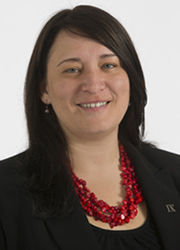Equal opportunity open forums conclude

Courtesy of University of Cincinnati
Jyl Shaffer
February 16, 2016
Jyl Shaffer, Title IX coordinator at the University of Cincinnati, spoke at the final director of equal opportunity open forum at 3 p.m. Monday at Morrill Hall about her top three issues involving Title IX and discrimination across campuses in America.
Shaffer addressed these problems through a strategic plan that outlined her solutions for equal opportunity violations.
Shaffer began by addressing that many equal opportunity offices as well as equal opportunity professionals forget to include the victim in Title IX violations and do not put trauma at the height of their focus.
“When we approach many of these issues, we take away all of the reality of what someone is feeling because of discrimination and forget that they have been harmed,” Shaffer said.
Outlining the Black Lives Matter campaign as a major stepping stone toward being trauma informed and victim centered, Shaffer said she sees staff as opportunities to become more informed and sensitive about issues of abuse.
She then looked toward the current legislature that protects against discrimination, stating that many of these laws were written in a time of extreme prejudice and are able to handle the subtle infractions in today’s world.
“Leaders of the Civil Rights Movements were thinking to themselves that it would be better to let the little fish swim and work on tackling the big fish first,” Shaffer said.” We’ve now fought the big fish and what remains are the little fish and they do hurt.”
Major talking points for Shaffer were the macro and micro issues of discrimination that cover a diverse range of topics and incidents. Macro situations are of a higher magnitude, such as race-divided schools, versus smaller micro problems such as loaded language in the classroom.
Shaffer sees macro issues as solved, if not almost under control. Her strategic plan would involve addressing the micro issues that are often overlooked by equal opportunity professionals and classroom staff.
As a final point, Shaffer explained the two different versions of diversity existing on college campuses today.
“There’s a difference between thriving and surviving at a college,” Shaffer said. “You can’t just have a diverse student body if you aren’t willing to help those diverse students thrive. You have to ask if there is a town of diversity where these people can leave campus and find and enjoy a community of their own.”
Shaffer wrapped up her presentation by explaining how her office would be used as a tool for students who feel they have been in a discriminatory situation.
“How do we serve as a place that coaches people?” Shaffer said. “So when someone comes in and says that they feel like their professor or colleague is treating them in a certain way, we need to be able to make sure and talk with those people and ask if they have the emotional energy to speak because after such an incident, they may not be ready to come out and talk.”
















